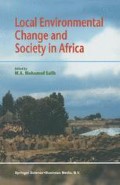Abstract
The Kingdom of Swaziland lies between latitudes 25 44 and 27 19 South and longitudes 30 47 and 32 07 East. The longest distance from north to south is 194 km. and from east to west is 145 km. Its area is 17,360 km sq. Table 1 shows the major characteristics of the four ecological zones and how relief, soils and rainfall affect the resource potential of these ecological zones. Apparently, there are two contradictory environmental management trends in Swaziland which, if not checked, can lead to a major crisis in resource use and affect drastically the sustainability of agricultural production. First, the size of the country is relatively small (17, 360 km sq.) and according to 19998 figures is inhabited by approximately 950,000 people. Land tenure is such that only 52% of the land is available to smallholder farms (Swazi Nation Land — SNL) inhabited by 70% of the population. It is estimated that 47% of the land is owned by 8 % of the populations with large-scale individual farms (ITF). Second, land use is ill planned or allocated to inappropriate uses coupled with the lack of land capability assessment measures to ensure long-term investments in land management.
Access this chapter
Tax calculation will be finalised at checkout
Purchases are for personal use only
Preview
Unable to display preview. Download preview PDF.
References
Allan, W. (1965) The African Husbandman, Edinburgh: Oliver and Boyd.
Armstrong, A. 1985. Legal Aspects of Land Tenure in Swaziland. Mbabane.
Blaikie, P. M. and H. C. Brookfields (1986) Land Degradation and Society — London Methuen.
Bootsman, C. S. and C. F. Schmidt (1983) A Spatial Analogue Model of Potential Desertificiation in Swaziland. Desertification Control, 9:31–39.
Boserup, W. (1965) The Conditions of Agricultural Growth; The Economics of Agrarian Change Under Population Pressure. Aldine, Chicago.
Central Statistical Office, (1972) Agricultural Sample Census (SNL) 1971–1972. Mbabane.
(1978) Annual Survey of Swazi Nation Land 1971/1972–1976–1977. Mbabane, Swaziland Government.
Central Statistical Office, (1980) Report on the 1976 Swaziland Population Census. Mbabane, Swaziland Government.
Central Statistical Office, (1986) Swaziland Census of Agriculture 1983–1984. Mbabane, Swaziland Government.
De Vletter, F. (1983) The Swazi Rural Homestead. A Case Study of Subsistence, Wage Dependency and Misguided Rural Development. Cape Town. Carnegie Conference Paper 285.
Fair, T. J. D., and others, (1969) Development in Swaziland. Johannesburg: Wits University Press.
FAO, (1986) Food and Agricultural Organization of the U. N. 1986 Natural Resources and the Human Environment for Food and Agriculture in Africa. Rome: FAO (Environment and Energy Paper No. 6).
Food and Agriculture Organization of the U. N. (1985) Project Brief: Swaziland Rural Development Areas Programme. Rome 112/85 GV — SWA. 9PB.
Food and Agriculture Organization of the U. N. (1978 )Report on the Agroecological Zone Project Vol. 1 Methodology and Results from Africa. World Soil Resources Report 18. Rome.
Fowler, M. H. (1980) The Approaching Crisis: Population, land and agricultural production in Swaziland, Report of National Symposium on Population and Development. Mbabane: Ministry of Agriculture and Cooperatives, pp, 173-192.
Hance, W. A. (1970) Population and Urbanization in Africa. New York: Colombia University Press.
Hughes, A. J. B. (1972) Land Tenure, Land Rights and Land Communities on Swazi Nation Land. Durban: University of Natal Institute of Social Research.
Hunting Technical Services Ltd. (1983) Review of the Rural Development Areas Programme. Final Report and Annexes: Mbabane: Ministry of Agriculture and Cooperatives.
Malthus, T. (1978) The First Essay on Population: London.
Maro, P. S. (1988) Agricultural land management under population pressure, the Kilimangaro experience, Tanzania, Mountain Research and Development, Vol 8, No. 4 pp. 273–282.
Maro, P. S. (1975) Population Growth and Agricultural Change in Kilimangaro 1920–1970 University of Dar es Salaam: Bureau of Resource Assessment and Land Use Planning, Research Paper No. 40.
Murdoch, G. (1968) Soils and Land Capability in Swaziland, Mbabane: Ministry of Agriculure.
Natural Resources, Land Utilization and Energy Ministry (1986), Swaziland National Physical Development Plan. Saad Yahya Associates, Sir Alexander Gibbs and Partners (Africa).
Newman, J. L. and G. F. Marske 1984 Population Patterns Dynamics Problems. Prentice-Hall: England Wood Cliffs.
Nkambule, Noah (1988) “The National Land Use Plan Project” Ministry of Agriculture and Cooperatives, Mimeo.
Nsibandze B. M. (1987) History of Soil Conservation in Swaziland, in Peoples Participation in Soil and Water Conservation. SADCC Soil and Water Conservation and Land Utilization Programme Seminar. Maputo, 2-6, 1987 Report No. 10.
Proctor J. D. (1988) “Growth Beyond Limits?” Resource Sufficiency in Rural Swaziland, 1974 to 2000: (Mbukwane-Maseyisini area). M. A. Thesis in Geography. University of California at Berkeley.
Reij, C. (1984) Back to the Grass Strips. An analysis of Soil Conservation Policies in Swaziland. University of Swaziland. Mimeo.
Richard P. (1983) “Ecological Change and the Politics of African Land Use”. The African Studies Review, Vol 26, No. 2. June 1983. (UCLA).
Roder, W. (1977) Environmental Assessment Swaziland Rural Development Areas Programme. Final Report. (Contract No. AID 690 — 003-T—) University of Cincinati and University of Zambia.
Russel, M. (1985) A Report on Landlessness in Rural Swaziland. Draft presented to FAO.
Swaziland Government: (1986) Report on the 1966 Swaziland Population Census. Mbabane. Swaziland government.
Swaziland Government: (1984) Fourth National Development Plan 1983/84–1987/88. Mbabane. Swaziland Government.
Swaziland Government: (1984) Project Report of the Rural Development Areas Programme Phase III. Annex 1: Sub-Areas Description. Mbabane. Ministry of Natural Resources, Land Utilization and Energy.
USAID, (1980) Environmental Profile of Swaziland. Library of Congress: Science and Technology Division, Aid Control No. SA/TOA 1-77.
Editor information
Editors and Affiliations
Rights and permissions
Copyright information
© 2000 Springer Science+Business Media Dordrecht
About this chapter
Cite this chapter
Maro, P.S. (2000). Agricultural Land Management for Sustainable Production in Swaziland. In: Salih, M.A.M. (eds) Local Environmental Change and Society in Africa. Springer, Dordrecht. https://doi.org/10.1007/978-94-017-2103-5_5
Download citation
DOI: https://doi.org/10.1007/978-94-017-2103-5_5
Publisher Name: Springer, Dordrecht
Print ISBN: 978-94-017-2105-9
Online ISBN: 978-94-017-2103-5
eBook Packages: Springer Book Archive

